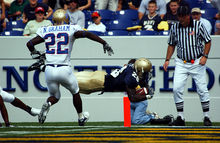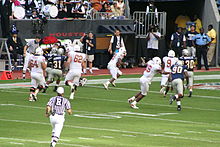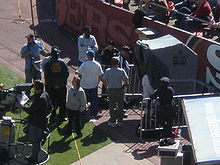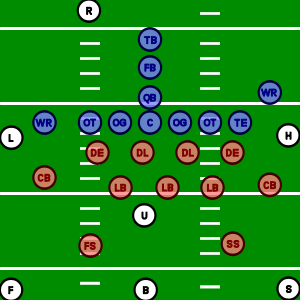- Official (American football)
-
In American football, an official is a person who has responsibility in enforcing the rules and maintaining the order of the game.
During professional and college football games, seven officials operate on the field. Arena football, high school football, and other levels of football have other officiating systems.
Football officials are commonly referred to as referees, but each position has specific duties and a specific name: referee, umpire, head linesman, line judge, back judge, side judge, and field judge. Because the referee is responsible for the general supervision of the game, the position is sometimes referred to as head referee.[1][2][3]
Contents
Equipment
 An official (right) watches Navy's Shun White (#26) score a touchdown. Visible on his belt are his yellow penalty flag and an orange bean bag.
An official (right) watches Navy's Shun White (#26) score a touchdown. Visible on his belt are his yellow penalty flag and an orange bean bag.
American football officials generally use the following equipment:
- Whistle
- Used to signal a reminder to players that the ball is dead, i.e., that the play has ended or never began.
- Penalty marker or flag
- A bright yellow colored flag that is thrown on the field toward or at the spot of a foul. For fouls where the spot is unimportant, such as fouls which occur at the snap or during a dead ball, the flag is typically thrown vertically. The flag is wrapped around a weight, such as sand or beans (or occasionally ball bearings, although this has been discouraged since an incident in an NFL game showed those could injure players), so it can be thrown with some distance and accuracy. Officials typically carry a second flag in case there are multiple fouls on a play. Officials who run out of flags when they see multiple fouls on a play may drop their hat or a bean bag instead.
- Bean bag
- Used to mark various spots that are not fouls but which may be possible spots of penalty enforcement or illegal touching of a scrimmage kick. For example, it is used to mark the spot of a fumble or where a player caught a punt. It is typically colored white, blue, or orange, depending on the official's league, college conference, level of play, or weather conditions. Unlike penalty flags, bean bags may be tossed to a spot parallel to the nearest yard line, not necessarily to the actual non-penalty spot. [4]
- Down indicator
- A specially designed wristband that is used to remind officials of the current down. It has an elastic loop attached to it that is wrapped around the fingers. Usually, officials put the loop around their index finger when it is first down, the middle finger when it is second down, and so on. Instead of the custom-designed indicator, some officials use two thick rubber bands tied together as a down indicator: one rubber band is used as the wristband and the other is looped over the fingers. Some officials, especially Umpires, may also use a second indicator to keep track of where the ball was placed between the hash marks before the play (i.e. the right hash marks, the left ones, or at the midpoint between the two). This is important when they re-spot the ball after an incomplete pass or a foul.
- Game data card and pencil
- Officials write down important administrative information, such as the winner of the pregame coin toss, team timeouts, and fouls called. Game data cards can be disposable paper or reusable plastic. A pencil with a special bullet-shaped cap is often carried. The cap prevents the official from being stabbed by the pencil while it is in his pocket.
- Stopwatch
- Officials will carry a stopwatch (typically a digital wristwatch) when necessary for timing duties, including keeping game time, keeping the play clock, and timing timeouts and the interval between quarters.
Uniform
For ease of recognition, officials are traditionally clad in a black-and-white vertically striped shirt, white knickers with a black belt, black shoes, and a peaked cap. A letter indicating the role of each official appears on the back of the shirt at college and NFL levels. Shortly after the September 11, 2001 attacks, an American flag was added to the shirts of NFL officials.
The stripes were first introduced in the 1920s, before which plain white shirts were worn. College football referee Lloyd Olds is credited with the idea after a quarterback mistakenly handed the ball to him.[5] The officials are colloquially called "zebras" due to their black-and-white striped shirts.[6]
During the American Football League's existence (1960-1969), officials wore red-orange striped jerseys. The referees wore red hats, the others white, each with the AFL logo. This look was recreated in 2009 during AFL Legacy Weekends to mark the 50th anniversary of the AFL's founding.
The United Football League, which launched play in October 2009, featured officials wearing solid red shirts (no stripes) with black numbers and black pants. As no teams in the league wore red or orange, there was no prospect of a clash of colors. From 2010, the UFL switched to a customised version of the traditional stripes.
Stripes on officials' shirts in high school are one inch wide and in college are two inches wide; NFL officials wear shirts with an uneven striping pattern. High school and college officials wear socks with a "Northwestern stripe" pattern, while NFL officials wear socks with two white stripes bordering one black stripe.
In 2006, the NFL completely redesigned the shirts, going to a sleeker-looking uniform which, however, no longer identified a given official's position from the front. Also new for 2006 were black pants with a white stripe down the side to be worn in cold weather. These looser-fitting pants allow for layering of warmer clothes underneath.[7] During the 2010 season, college officials and, in many states, high school officials, will have the option of wearing the black cold-weather pants. The black pants became mandatory for college officials in 2011.
For several decades, all NFL officials wore white hats. In 1979, the referees changed to black hats with white stripes, while the other officials continued to wear white ones. Finally, in 1988, the NFL switched to the high-school and college football style: the referee wears a white hat (which now includes the NFL logo, first added for Super Bowl XXXIX), and the other officials wear black hats with white stripes.
Officials' hats are also occasionally used as additional equipment. If a player not carrying the ball steps out of bounds (a wide receiver running a deep passing route or a player running downfield on punt coverage, for example), the official will drop his hat to mark the spot of where the player went out of bounds. The hat also is often used to signal a second foul called by the official on a play (by those officials that may carry only one flag); to indicate unsportsmanlike conduct committed against the official himself (as when a player shoves an official); or when some other situation requires a physical mark and the official has already used the ordinary item on the play. Some conferences discourage the use of the hat in these situations, and the bean bag will be used instead.
Officiating systems
The NFL and College Football primarily use a seven-official system. On the other hand, Arena football, high school football, and other levels of football have other officiating systems.
- A three-official system uses only the referee, head linesman, and line judge, or in some cases, referee, umpire and head linesman. It is common in junior high and youth football.
- A four-official system uses the referee, the umpire, the head linesman, and the line judge. It is primarily used at lower levels of football, including junior varsity and some high school varsity.
- A five-official system is used in arena football, most high school varsity football, and in most semi-pro games. It adds the back judge to the four-official system.
- A six-official system uses the seven-official system, without the back judge. It is used in some high school and small-college games.
Positions and responsibilities
The following are the positions and responsibilities in the standard seven-official system. Differences used for the other officiating systems are also noted.
Referee
Referee Ron Winter reviews a play in the replay booth during a game on November 2, 2008 between the San Francisco 49ers and Philadelphia Eagles.
The referee (R) is responsible for the general supervision of the game and has the final authority on all rulings. Thus, this position is sometimes referred to as head referee and is considered to be the crew chief. He can be identified by his white cap, while the other officials wear black ones.
During each play from scrimmage, the referee positions himself behind the offensive team, favoring the right side (if the quarterback is a right-handed passer). He also counts offensive players.
On passing plays, he primarily focuses on the quarterback and defenders approaching him. The referee rules on possible roughing the passer and, if the quarterback loses the ball, determines whether it is a fumble or an incomplete pass.
On running plays, the referee observes the quarterback during and after the time he hands off (or laterals) the ball to the running back, remaining with him until the action has cleared just in case it is really a play action pass or some other trick passing play. After it has been established that the running back will keep the ball, the referee then checks the running back and the contact behind him.
During punts and field goals, the referee observes the kicker (and holder) and any contact made by defenders approaching them. On a punt out of bounds, he uses his vantage point behind the punter to direct the nearest sideline official to the spot where the ball went out of bounds.
In college football, the NFL and other professional leagues, and in some high school games, the referee announces penalties and the numbers of the players committing them (college and professional), and clarifies complex and/or unusual rulings over a wireless microphone to both fans and the media.
During instant replay reviews in the NFL and college football, the referee confers with a replay official, who is stationed in the press box above the field, on the play and then announces the final result over the wireless microphone. For replays in the NFL, the referee also views the play on a monitor stationed near the sidelines and makes the final decision; the replay official makes the final judgment in college football.
In addition to the general equipment listed above, the referee also carries a coin to conduct the pregame (and if necessary, overtime) coin toss.
Umpire
 An umpire watches a play from behind the defensive line during a game between the UCLA Bruins and the California Golden Bears.
An umpire watches a play from behind the defensive line during a game between the UCLA Bruins and the California Golden Bears.
The umpire (U) stands behind the defensive line and linebackers (except as described below for the NFL), observing the blocks by the offensive line and defenders trying to ward off those blocks — looking for holding or illegal blocks. Prior to the snap, he counts all offensive players.
During passing plays, he moves forward towards the line of scrimmage as the play develops to (1) penalize any offensive linemen who move illegally downfield before the pass is thrown or (2) penalize the quarterback for throwing the ball when beyond the original line of scrimmage. He also assists on ruling incomplete passes when the ball is thrown short.
As the umpire is situated where much of the play's initial action occurs, he is considered to hold the most dangerous officiating position.[6] For this reason, the NFL carried out experiments in the 2001 preseason with the umpire placed in the offensive backfield adjacent to the referee.[8] In March 2010, the NFL announced that this repositioning would be permanent, after five major injuries were suffered by umpires in 2009 (two concussions and three knee or shoulder surgeries).[9] During the last two minutes of the first half, the last five minutes of the second half, and anytime when the offense is inside the five-yard line however, the umpire returns to the defensive side of the line of scrimmage during plays.
In addition to his on-field duties, the umpire is responsible for the legality of all of the players' equipment.
Head linesman
The head linesman (H or HL) stands at one end of the line of scrimmage (usually the side opposite the press box), looking for possible offsides, encroachment and other fouls before the snap. As the play develops, he is responsible for judging the action near his sideline, including whether a player is out of bounds. During the start of passing plays, he is responsible for watching the receivers near his sideline to a point 5-7 yards beyond the line of scrimmage.
He marks the forward progress of the ball and is in charge of the chain crew in regard to its duties. In addition to the general equipment listed above, the head linesman also carries a chain clip that is used by the chain crew to properly place the chains and ensure an accurate spot when measuring for a first down.
Line judge
The line judge (L or LJ) assists the head linesman at the other end of the line of scrimmage, looking for possible offsides, encroachment and other fouls before the snap. As the play develops, he is responsible for the action near his sideline, including whether a player is out of bounds. He is also responsible for counting offensive players.
During the start of passing plays, he is responsible for watching the receivers near his sideline to a point 5-7 yards beyond the line of scrimmage. Afterwards, he moves back towards the line of scrimmage, ruling if a pass is forward, a lateral, or if it is illegally thrown beyond the line of scrimmage.
On punts and field goal attempts, the line judge also determines whether the kick is made from behind the line of scrimmage.
In high school (four-man crews) and minor leagues, the line judge is the official timekeeper of the game. In the NFL, college and other levels of football where the official time is kept on the stadium scoreboard clock, the line judge becomes the backup timekeeper.
Field judge
The field judge (F or FJ) works downfield behind the defensive secondary on the same sideline as the line judge. He makes decisions near the sideline on his side of field, judging the action of nearby running backs, receivers and defenders. He rules on pass interference, illegal blocks downfield, and incomplete passes. He is also responsible for counting defensive players. He has sometimes been the official timekeeper, and in a number of leagues will run the game clock on a six-man crew.[10][11]
With the back judge, he rules whether field goal attempts are successful.
Side judge
The side judge (S or SJ) works downfield behind the defensive secondary on the same sideline as the head linesman. Like the field judge, he makes decisions near the sideline on his side of field, judging the action of nearby running backs, receivers and defenders. He rules on pass interference, illegal blocks downfield, and incomplete passes. He also counts defensive players. During field goal attempts he serves as a second umpire.
In college football, the side judge is responsible for either the game clock or the play clock, which are operated by an assistant under his direction.
Back judge
Back judge Lee Dyer picks up a penalty flag during a game on November 16, 2008 between the San Francisco 49ers and St. Louis Rams.
The back judge (B or BJ) stands deep behind the defensive secondary in the middle of the field, judging the action of nearby running backs, receivers (primarily the tight ends) and nearby defenders. He rules on pass interference, illegal blocks downfield, and incomplete passes. He covers the area of the field in between himself and the umpire. He has the final say regarding the legality of kicks not made from scrimmage (kickoffs).
With the field judge, he rules whether field goal attempts are successful.
In the NFL, the back judge is responsible for ruling a "delay of game" infraction if the play clock expires. In college football, the back judge is responsible for either the game clock or the play clock, which are operated by an assistant under his direction. In high school (five-man crews), the back judge is the official timekeeper of the game. The back judge is also the keeper of the play clock in high school games, and times the one minute allowed for time outs (only 30 seconds are allowed during team time outs during televised college games to reduce time).
In four games in the 2010 preseason, the NFL experimented with an eighth official, a deep judge, in the defensive backfield opposite the back judge. Primary responsibility for this new position is the action of receivers, and it allowed the NFL to adjust coverage after the umpire was moved to the offensive backfield. The experiment was continued for 12 games in the 2011 preseason, but any decision to add the extra official would have to be approved by ownership.[12]
Transitioning during turnovers, punts, and other returns
During turnovers, punts, and other returns by the defense, and play transitions from one direction to the other, the officials must also adjust. The Field Judge, Side Judge, and Back Judge then become the trail/back positions; and the Referee, Head Linesmen, and Line Judge then become the lead/front positions. The Umpire, in his traditional position in the middle of the field, usually stays stationary until the returner and the other players pass him.
History
When the NFL began play, only three officials (referee, umpire, and head linesman) were used. The field judge was added in 1929 and the back judge in 1947. In response to scrambling quarterbacks, namely Fran Tarkenton, the line judge was added in 1965 to watch the other side of the line of scrimmage. The side judge was added for 1978, as the NFL included new rules to open up the passing game.
The practice of having the referee announce penalties or clarify complex and/or unusual rulings over a wireless microphone started in the NFL in 1975. College football and other professional leagues soon adopted this practice.
For years, college football referees were prohibited from announcing the number of a fouling player, except in the Mountain West Conference (and in all conferences when ejecting the offending player). In 2004, the rules were changed throughout college football to permit the fouling player's number to be announced.
Among the various Halls of Fame for major North American sports, the Pro Football Hall of Fame is unique in that it has not inducted any officials; the Baseball Hall of Fame, Basketball Hall of Fame and Hockey Hall of Fame have each inducted game officials as members.
Employment status
Because their regular season spans only 17 weeks, the NFL is the only major sports league in the United States that only pays their officials on a contract basis as opposed to being full time salaried employees. Advantages to this system include being able to eliminate unqualified officials simply by not offering them a contract the following season, where terminating full-time employees would require them to show cause. Critics argue that full-time officials would free them from the distractions of a second job, but proponents of part-time officials point out that the NFL would lose a number of qualified officials because many of them are owners, presidents, or C.E.O.s of various companies. Proponents also argue that there is only one game per week and the regular season is only 4 months long, and that having full-time officials does not necessarily guarantee that they will make fewer officiating mistakes. The level of training and review in which NFL officials participate makes additional time redundant. In any event, veteran officials can make quite substantial salaries for their work.
See also
- American Football League Officials
- List of current and former NFL officials
- Super Bowl officials
- Art McNally Award
- American football rules
References
- ^ Markbreit, Jerry (November 23, 2005). "Jerry Markbreit's answers: The former NFL referee answers readers' questions each week throughout the season". Chicago Tribune. http://chicagosports.chicagotribune.com/sports/football/bears/askthereferee/cs-051123askjerrymarkbreit,1,1965045.story?coll=cs-bears-asktheref-headlines.
- ^ Pascoe, Bruce (August 14, 2006). "Grad of CDO finds fame as NFL referee". Arizona Daily Star (Tucson). http://www.azstarnet.com/sports/141999.
- ^ Zimmerman, Lisa (July 10, 2001). "Replay booth: Positively no visitors". NFL.com. Archived from the original on 2007-07-17. http://web.archive.org/web/20070717191834/http://www.nfl.com/news/story/4380287. Retrieved 2007-03-10.
- ^ "SFFOA Oritentation Guide". South Florida Football Officials Association. April 1, 2009. http://sffoa.tripod.com/sitebuildercontent/sitebuilderfiles/sffoagmacfoaorientationguide.doc. Retrieved 2009-10-19.
- ^ Uni Watch: How the zebra got its stripes, Slate.com
- ^ a b Roberts, Rich (October 24, 1985). "AN NFL UMPIRE'S . . . LIFE IN THE WAR ZONE - For His Own Protection, This Official Must Read Defenses and Offenses; Draw Plays Are Murder". Los Angeles Times. http://articles.latimes.com/1985-10-24/sports/sp-12838_1. Retrieved 2009-09-02.
- ^ ESPN - Fashion statement: NFL refs to sport new uniforms - NFL
- ^ "NFL experimenting with putting umpire in offensive backfield". CBC. August 4, 2001. http://www.cbc.ca/sports/story/2001/08/04/umpire010804.html. Retrieved 2009-10-23.
- ^ Mortensen, Chris (March 22, 2010). "NFL moves umpires for safety's sake". ESPN. http://sports.espn.go.com/nfl/news/story?id=5016012. Retrieved 2010-03-23.
- ^ GHSA Football Officials Manual 2009. Georgia High School Association. p. 60. http://www.ghsa.net/files/documents/2009%20GHSA%20Football%20Officials%20Manual%20Rev%20D.pdf.
- ^ "2009 FOOTBALL MANUAL For IOA Officials, Observers, Athletic Directors, and Coaches". Intercollegiate Officiating Association. pp. 12. http://www.northcoast.org/ioa/ioafbmanual09.pdf. Retrieved 26 February 2010.
- ^ "NFL experimenting with 8th on-field official". August 25, 2011. http://www.google.com/hostednews/ap/article/ALeqM5h0B2u0HKbd_D1DO4jr9FVEW_jeNg?docId=6c06f8ddd12e4b8d9622f2396cda6b84. Retrieved August 25, 2011.
External links
- NFL.com - official site - rulebook - digest of rules
- NFL.com - official site - rulebook - official signals
- KJZZ.com - The Double Life of Ed Hochuli
- football.refs.org - officiating rules and mechanics for college and high school football.
- USA Football - officiating center
- American Football - Officiating at the Open Directory Project
Categories:- American football officials
- American football personnel
- Sports officiating
Wikimedia Foundation. 2010.





